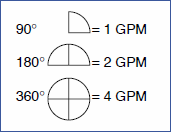Application Rates
Watering application rates will vary with different types of plants, soils and climates. New lawn must be kept moist, and newly-transplanted shrubs must be watered every day or two. Established plants will need deeper, less frequent watering. The following guidelines will get you started.
Watering Guidelines
1. Do not operate more than one valve at a time.
2. Water early in the morning when it is least windy and pressure is the greatest. Early morning watering will also reduce water evaporation. Watering in the early evening is not recommended. A lawn is more likely to get diseases when wet for a long duration, especially overnight during the summer. Watering on a hot summer day may also burn the plants.
3. In most areas, lawns require 1½” to 2″ of water per week in the hottest months. Hot and arid areas may require more.
4. Manually activate your system every week or so to make sure everything is operating correctly. Check and clean sprinklers to ensure proper functioning.
Choosing Sprinkler Nozzles
When designing an irrigation system, it is important to ensure that the precipitation (rate at which water is applied) is even over each zone of coverage. “Matched precipitation” is accomplished by selecting the appropriate nozzles, or zoning together sprinklers with the same precipitation rate. The two criteria to consider are a sprinkler’s flow rate and arc of coverage. The illustration (below) depicts three different sprinkler heads with matched precipitation rates. In each case, one gallon per minute (GPM) is applied to each quarter circle and precipitation is therefore matched.
